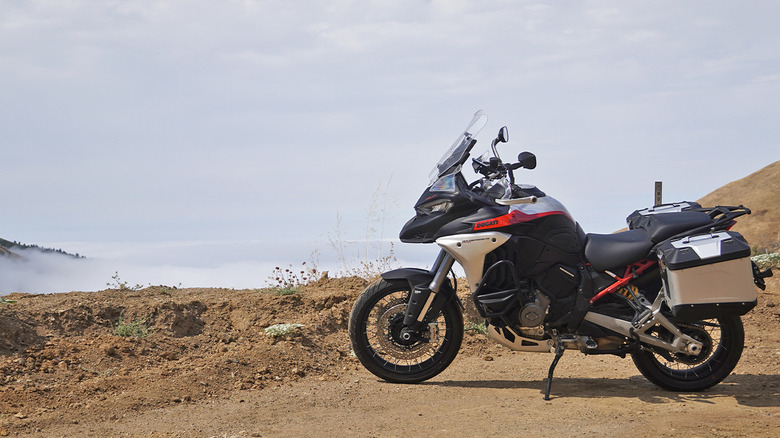
Michael Teo Van Runkle/SlashGear
When the day most likely to take top honors as «best of the year» flies by in July, optimism for the remaining five months can start to wither and wilt. In short, I plan to blame Ducati for my seasonal affective disorder this year, after spending a full day of motorcycle nirvana at WeatherTech Raceway Laguna Seca spinning laps on the 2024 Panigale V2 and V4 S.
Advertisement
As I look back on the trip, the adventure up to DRE at Laguna Seca from Los Angeles plays second fiddle to the track time. Which almost feels sacrilegious to write, since I spent two full days riding along the central coast with Ducati North America CEO Jason Chinnock on a pair of Multistrada V4 Rally touring bikes. The second-to-newest Multistrada variants proved themselves as eminently capable and comfortable steeds for the ride, before a brief interlude on the newest of the bunch — a Multistrada V4 RS at Laguna Seca — then rendered any such judgments almost entirely moot.
A new Rally trim for the multifaceted Multistrada
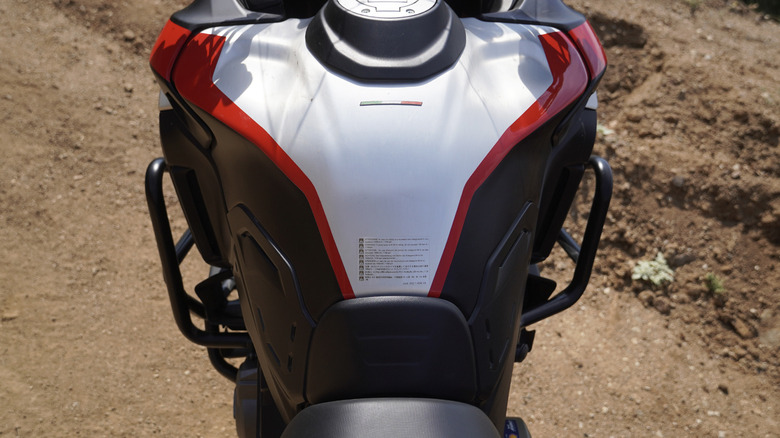
Michael Teo Van Runkle/SlashGear
When Chinnock and I met in Santa Monica to kick off our caper, he regaled me with stories about begging, pleading, insisting, almost cajoling Ducati to build the Multistrada’s most famous iteration, the Pikes Peak edition. I rode the latest Pikes Peak about a year previously, and remember my mind balking at how well such a large and upright tourer nonetheless handled in the tight canyons of Malibu where I tend to test bikes.
Advertisement
If the Pikes Peak qualifies as the Multistrada lineup’s decathlete, capable of doing everything and anything, the newer Rally package purposefully caters more to longer trips further off the beaten path. Most importantly, a new aluminum fuel tank increases overall capacity to 7.9 gallons for increased range.
The same 1,158cc Granturismo V4 still pumps out 170 horsepower and 89 lb-ft of torque, and can reportedly average 36 miles to the gallon, meaning that a full tank can theoretically last for almost 300 miles. A wider range of suspension settings for the adjustable dampers also feature additional travel to allow for 7.9 inches of travel and more ground clearance, though riding off-road likely reduces the maximum fuel economy.
Advertisement
Adjusting to motorbike touring
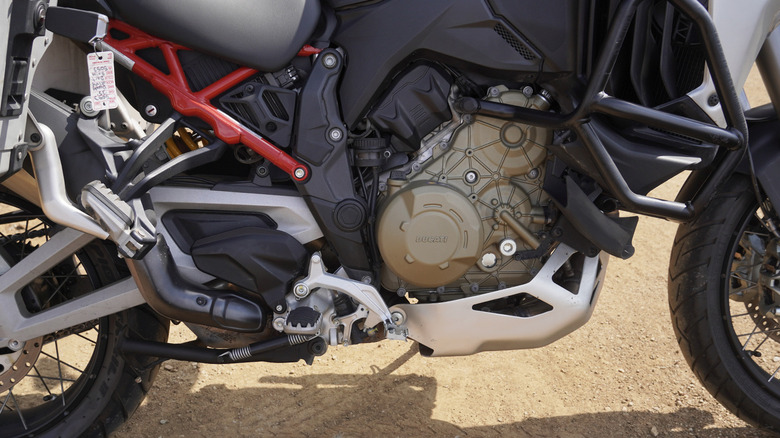
Michael Teo Van Runkle/SlashGear
The Rally weighs 500 pounds dry, so with me plus my gear and crash bars and two rigid panniers packed to the brim, all in that Granturismo engine probably needed to haul around north of 750 pounds or so. Not exactly ideal for gravel roads, yet as we pulled out onto the Pacific Coast Highway, I never even reached anywhere near full throttle. More importantly, the Multistrada’s geometry and upright posture helped me negotiate crowded bottlenecks and even lane-split without too much concern.
Advertisement
Part of my confidence came from watching Chinnock lanesplitting ahead of me, and noticing that his panniers only extended just about the exact same width as his handlebars. So, as long as my front end cleared the rearview mirrors left and right, I should be good. With lightened multispoke wheels — including a larger 19-inch up front — and the Öhlins suspension set to Urban, I cruised around nimbly. Even the gas tank between my knees measures the same as the other Multistradas, despite the additional capacity. Those early portions of road riding helped contribute to my sense of excitement about the rest of the trip to come, which promised to just about triple the longest day of my riding life up to that date.
Advertisement
Everything for the truly grand tours
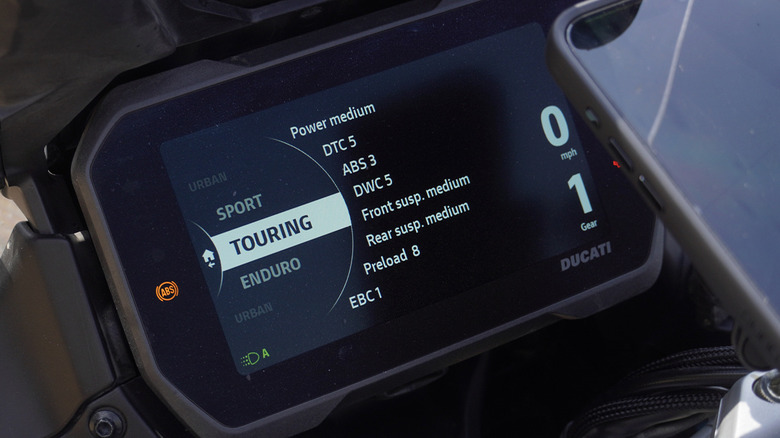
Michael Teo Van Runkle/SlashGear
The Rally’s easy throttle modulation helped, too. The three other ride modes switch up more than just suspension damping, though. Enduro, in particular, caught my eye with a novel «Power» mode that reduces output to just 114 horsepower, changes up the traction control programming, and turns the rear wheel ABS off to allow for slides in dirt. At stoplights, the Rally also deactivates the V4’s two rear cylinders to conserve fuel.
Advertisement
Once the traffic started to melt away, Chinnock and I started exploring further into the Rally’s touring characteristics. Slouching a bit as we cruised, using the quickshifter to stay in the proper rev range and keep the engine vibrations to a minimum, I occasionally dipped into throttle for a few hard pulls on straightaways. Higher up toward the 10,500-rpm redline, the soundtrack never roared or rollicked, just maintained a steady mechanical resonance—nothing flashy, just plenty of power available at a moment’s request.
Still retains sporting aspirations
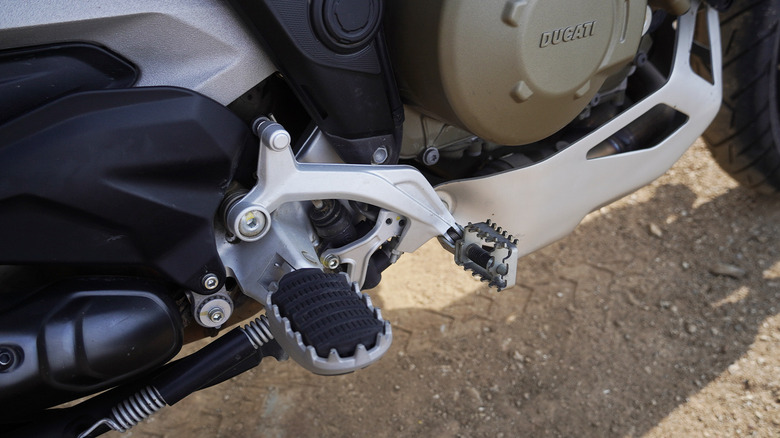
Michael Teo Van Runkle/SlashGear
Then, we found a tiny little winding road up and out of Santa Barbara that dictated switching into Sport mode to firm up the suspension. Here, I tried to keep the engine spinning higher up in the tach, too, for a bit of rear wheel engine braking effect. And again, even leaning over more than I thought possible, the packed panniers never caused any moments of agitation for the Rally’s suspension.
Advertisement
Though we never spent any serious time truly off the tarmac, the Rally features a few more nifty details that bear mentioning. The rear brake foot lever, for example, can spin 90 degrees at the end for better grip while standing up out of the saddle. The panniers also pop off and on easily, just in case the trail tightens up or gets technical enough to demand weight reductions—much more likely to occur with the 95% street-focused Pirelli Scorpion Trails on my bike, and a set of knobbier tires might help on trips with more dirt than asphalt. While the Multistrada V4 suits larger riders well, for those with shorter legs the Rally can drop all spring preload at the push of a button, to lower the seat at low speeds.
Advertisement
Not entirely stoked on motorcycle touring
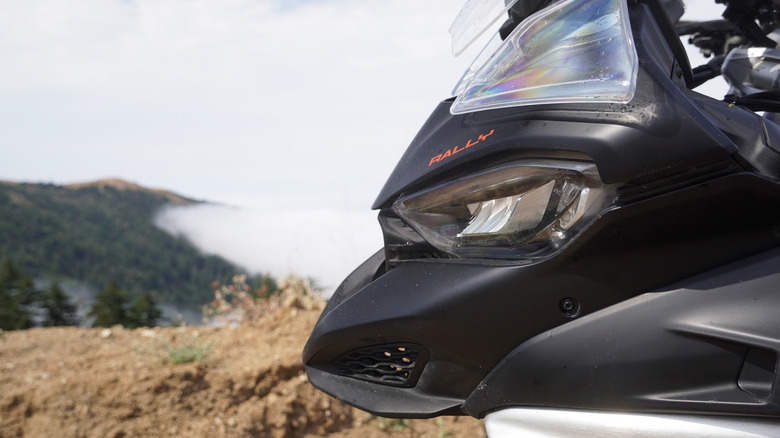
Michael Teo Van Runkle/SlashGear
This journey also marked my first time using a motorcycle’s cruise control for extended periods. While I always test how cruise works on loaner bikes, this time around I actually needed to give my right wrist and grip some breathers after hours on the road. And in all honestly, my back and knees also started to ache regularly, so I stood up repeatedly to stretch out the old bones. Another reminder to cut out the slouching, perhaps…
Advertisement
During the periods when we left the cooler coastline behind and needed to traverse long, straight sections of California’s central valley, I definitely started to miss an enclosed automobile with air conditioning. Although the Rally’s fairings purposefully route fresh air toward the seat, the V4 still radiates enough heat that I occasionally scooted back on the pillion pad, too.
My mind wandered, flitting between nerves about the V4 S on track at Laguna Seca and plans for future trips, theories about the state of automotive journalism as a whole, and how stories should focus more on how the vehicles allow for experiences—much as the Rally’s range and capability allowed us to explore a few portions of backroad that I simply cannot reveal in print (even on the internet). That range proved fairly realistic, as I kept track of fuel economy. We played it safe, yet consistently achieved over 240 miles per tank including city, highway, and sporty riding.
Advertisement
Into Monterey on the Multistrada Rally
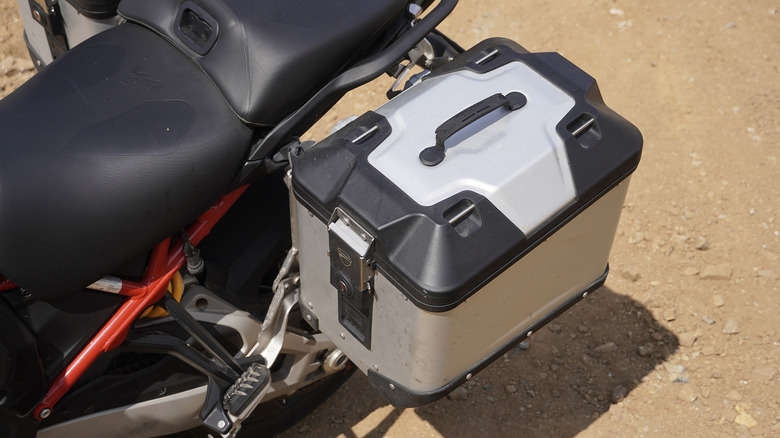
Michael Teo Van Runkle/SlashGear
Once we turned back off the 101 and headed in Monterey, though, the temperatures dropped quickly and I snapped back to reality. Weather at Laguna Seca famously never respects any semblance of a meteoroligist’s forecast, and I woke up for the track day wondering whether morning mists might cause any slip-and-sliding. Luckily, the warm air followed us and the fog started to burn off during my first sighting lap out on the Panigale V2.
Advertisement
Jumping onto a sporty Panigale — one of Ducati’s fastest models — after two days on the Multistrada V4 Rally demanded a bit of an adjustment period, but my road cyclist’s background always helps me feel most comfortable with handlebars lower than my seat. Then, leaping up to the V4 S simply ratcheted the epicness up to a whole new level, with 210 horsepower from a screaming 1,103cc V4. But nothing compared to then acclimating to a few laps on the Multistrada’s newest variant, the RS that drops the same engine into a touring bike—for absolutely no rational reason whatsoever.
The spectacular bike that nobody needed
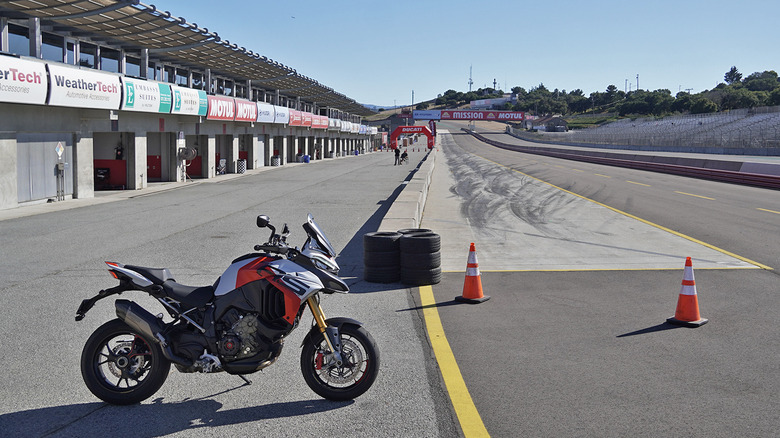
Michael Teo Van Runkle/SlashGear
Of course, just swapping in the Panigale’s Desmosedici Stradale V4 necessitated plenty of other revisions to the Multistrada, too. An Akrapovic silencer helps unleash a bit more beastly roar. New Öhlins suspension, a single-sided swingarm, and forged Marchesini wheels with a 17-inch front also fit into the package. Then bolt on plenty of carbon fiber, use titanium for the subframe, and install the dry clutch that chatters away in classic Ducati sport bike fashion.
Advertisement
All told, the Multi RS puts out 180 horsepower and 87 lb-ft of torque on the way to a redline of 13,500 RPM. Those numbers can’t quite match the engine’s Panigale application, though a shorter final drive ratio and the sheer physics of offering that much grunt in an upright bike that now weighs just 465 pounds dry create a fairly wild ride on track, to say the least. (And actually, in Sport and Race modes, the RS’s ECU even uses torque-by-gear programming.)
Upright, heavy, unnecessary, why not
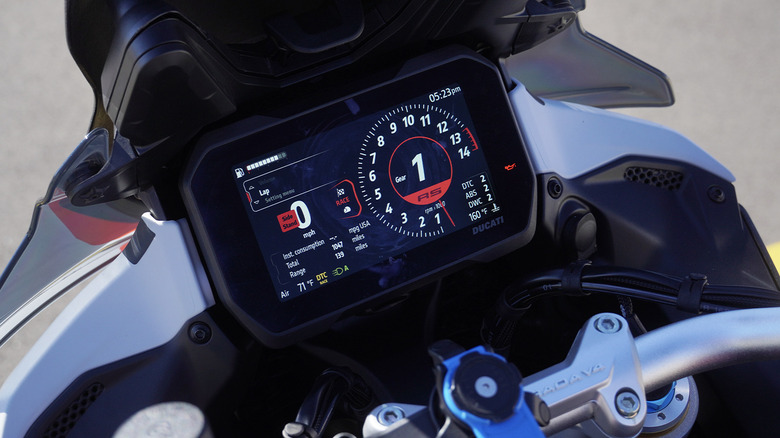
Michael Teo Van Runkle/SlashGear
My first couple of laps revealed just how much all the lessons learnt on the V2 and V4 S surprisingly carry over to such a radically different chassis. Soft and slow hands, body positioning, braking technique, lean angles, and throttle application all still apply. And thanks to spending two days on the Rally, the Multistrada never felt unwieldy in this more hardcore guise.
Advertisement
Higher footpegs versus the Rally, plus lower and narrower handlebars, helped me fit on the geometry while wearing a set of full leathers. I hung off the seat without feeling—or looking, I hope—overly cartoonish, as the long sweepers of Laguna Seca let me dip lower and lower toward apex, exploring where the RS can approach the greatest lean. The Diablo Rosso IV Corsa tires no doubt helped, but the unflappable suspension also contrasted so heavily versus the Rally’s softer, more compliant ride. Braking, in particular, showed how firmer forks prevent quite as much nose dive, putting more weight into the front tire sooner and allowing me to haul down speed with grip maxed out much earlier.
Engineering goes a long way
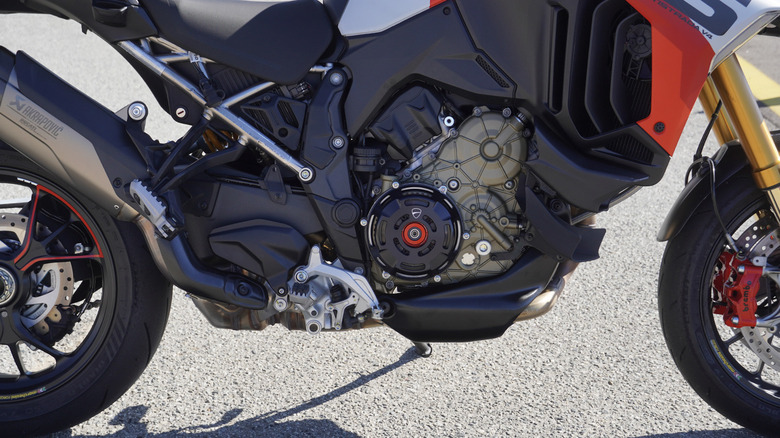
Michael Teo Van Runkle/SlashGear
I can admit to a certain element of surprise at the track capability that Ducati somehow shoehorned into an ADV platform—yet on sport bikes (and while driving cars), the Corkscrew arrives as little more than a technical challenge (and much less intimidating than Turn 1’s blind crest into the downhill approach to Turn 2).
Advertisement
On the Multi RS, by contrast, Turn 1 still forced me to consciously focus past the hill to stop from rolling off throttle too early, but the Corkscrew truly turned into a swan dive competition. After a bit more time, I suspect that sensation probably fades. Unfortunately (or fortunately, depending on perspective) I needed to hustle back to the pits and hop back on the Panigale V4 S, undoubtedly the best motorcycle ever made for fast lapping at Laguna Seca—other than the 2025 generation, apparently.
A one-bike solution for the one percent
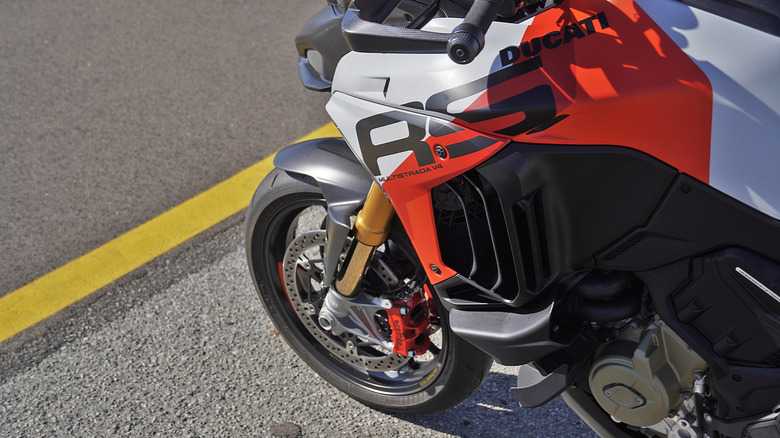
Michael Teo Van Runkle/SlashGear
Without a doubt, I definitely prefer sport bikes on track, and in general. For anyone who struggles physically with arm pump or neck fatigue or tight knees, though, the pace of a Multistrada RS might not sacrifice too much versus a lower, leaner, more purpose-built motorcycle. The pricing for a Multistrada V4 RS starts to eclipse any semblance of sanity for a track toy, though, at $37,995 to start. Plus, the Desmosedici engine and dry clutch and aggressively tuned suspension likely reduces the broader spectrum of uses that makes the Multistrada in Pikes Peak or Rally form so appealing in the first place.
Advertisement
Yet the Rally also starts at $31,496 (even if the Granturismo V4 earns 36,000-mile desmodromic service intervals versus the RS at 18,000 miles). So in the spirit of expenditure, why not commit to another 20 percent to jump on one of the most hilariously unnecessary motorcycles of all time? For the record, I fully support this kind of irrational and unnecessary decision, both by Ducati and by those customers who do want to shell out for an RS. After riding the Pikes Peak, then the Rally, and finally the RS, concepts of sanity simply start to adjust.
After all, even with the best day of the year almost certainly behind me, hope springs eternal that something more fun on the horizon might retake the title. And exactly that kind of optimistic mindset must surely apply to anybody who pictures the patently, wonderfully absurd Multistrada V4 RS as the perfect one-bike solution.
Advertisement